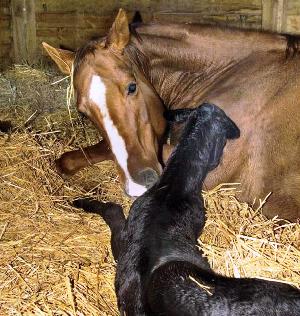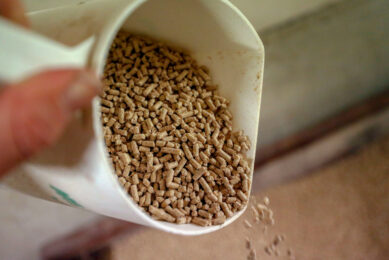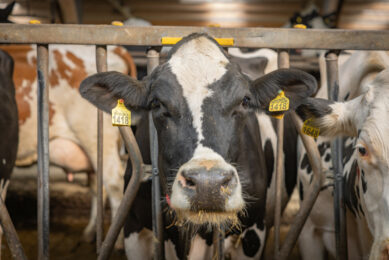Impact of live yeast on microflora establishment of the foal’s gut

Most foals will experience at least one episode of diarrhoea before reaching six months. Infectious diarrhoeas (viral or bacterial) are very common and can lead to health problems. Extra care must be taken to preserve the foal’s digestive equilibrium and microflora balance to avoid such consequences. Field trials performed in horses and foals and the good understanding of S. boulardii’s modes of action indicate a real potential of this live yeast to help control diarrhoeas in foals.
“Nature hates emptiness,” this is Aristotle’s famous theory which is perfectly illustrated when it comes to the digestive tract. In horse and any other mammals, the digestive tract is sterile at birth, but not for long. As soon as the expulsion process has started and during the first hours of life, it is rapidly colonised by microorganisms, first from the mother’s vagina, skin, teat and also milk, which is less sterile than initially thought. Then, the major source of microbial contamination, good or bad, comes from the foal’s direct environment: the box, the soil, and the mare faeces constitute the essential reservoir of digestive microorganisms for the newborn.As with any digestive ecosystem (and this is the rule with any ecosystem in general, big or small), the sequence of establishment of the different populations is essential and immutable, the first populations laying the ground for the latter ones etc. The digestive microflora is established before the animal receives solid food, i.e. the implantation of cellulolytic bacteria and fungi for example is not linked to the presence of grass in the diet but results from the interactions between the various microbes in the gut. Hence, the cellulolytic microflora is already in place when the animal needs it. It has been shown in several species that the sequential implantation of various microbial species is crucial and constant. In foals, the facultative anaerobes (Enterococci, Lactobacilli, Enterobacteria) colonise the gut first, and their presence is necessary. Indeed, at birth, the foal’s digestive tract is short and rich in oxygen: the environment has a high redox potential, lethal for anaerobes. By consuming the oxygen present in the gut, the facultative anaerobes decrease the redox potential and thus contribute in preparing the ground for the strict anaerobes, such as cellulolytic bacteria, which come later and soon overgrow the facultative anaerobes populations. As said earlier, it is interesting to note that cellulolytic bacteria colonise the gut as early as the first week of life, well before the ingestion of solid feed (Figure 1). At two months of age, their concentration has attained the same level as in the adult horse (105 CFU/g faeces).
The foal digestive microflora evolves rapidly to resemble the adult horse’s, where it is very diverse and very similar to the ruminant’s. The higher microbial content is found in the distal part of the tractus: caecum-colon. This part represents the most favourable environment for microbial development: a slow transit (36 hours on average), a stable temperature, stable pH (6.8 – 7).
Bacteria are the major populations. The anaerobes strict are found at a 108 – 109 CFU/ml level in the hindgut, colon and caecum. Their main roles are: fibre degradation, starch digestion, lactate utilisation. Among the identified types, the main ones are Streptococcus (bovis and equinus), Bacteroides and Lactobacillus (Table 1). Fungi represent only 8% of the biomass (102 – 104 spores/ml), and play a fibrolytic role, as in ruminants. Protozoa are also present to a lesser extent: 102 – 105cells/ml depending on the location: they are mainly located in the distal colon, where they also have a fibre-degrading role and degrade the remaining starch.
A fragile ecosystem
Many factors, linked to the foals’ physiology and environment, the mare’s condition etc. can impact the gut colonisation process and its fragile balance and this can lead to important digestive troubles, in particular infectious diarrhoeas which are quite common in foals and can have dramatic outcome due to dehydratation, acid base and electrolyte imbalance, and bacterial toxins effects. Vets usually recommend carefully monitoring the sick foals because their status can deteriorate very rapidly.
The main causative agents of infectious diarrhoeas in foals are:
- Bacteria: Salmonella spp, Clostridium perfingrens (types A and C are the most common) or Clostridium difficile (often associated with antibiotic use) are the most frequent. E. coli is a common cause of neonatal septicemia and is often listed as a cause of diarrhoea too. Less frequent is Cryptosporidium parvum, while Lawsonia intracellularis commonly causes diarrhoeas in older foals and weanlings.
- Viruses: rotavirus is a main cause of infectious diarrhoea, coronavirus can also be found.
As seen previously, the foal’s microflora originates principally from its mother (faeces ingestion is the major source of lactobacilli). In late gestation, the mare’s flora is modified and potentially weakened. Due to factors such as hormonal changes and large volume occupied by the uterus, the digestive transit is slowed down in the gestating mare. This, in turn, will have an impact on its gut microflora profile: slower transit often leads to dysfermentations in the hindgut, as a result certain microflora populations will increase at the detriment of others and the microflora can become unbalanced, with an excess of pathogens or potential pathogens, such as E. coli, Clostridia, coliforms. This will constitute an important source of ‘bad contamination’ for the foal. Lactobacilli are part of the early colonising populations (facultative anaerobe). They first establish in the small intestine, where they produce lactic acid. This leads to local pH drops along the gut wall, which will inhibit the development of Gram negative bacteria, such as E. coli, responsible for numerous cases of foal’s diarrhoeas, often severe or even fatal. Other opportunistic pathogens (i.e. bacteria which are normally present in small number, without detrimental effect and which can become pathogen when their population grow), such as clostridia, for example, often issued from an unbalanced mare’s microflora, can take advantage of the gut’s immature, uncontrolled environment to grow rapidly and either cause or complicate early diarrhoeas in the foal. Moreover, the foal’s immune system at birth is always immature. Its maturation is progressive and linked to maternal milk ingestion; in particular the colostrum is crucial. When the foal’s immune system does not have a chance to develop properly, the young will be more sensitive to pathogens.Diarrhoea can interfere with normal foal growth, resulting in long treatment periods and may be fatal. Prevention methods include management practices, in particular hygiene. Veterinarians do not recommend, however, the preventive use of broad spectrum antibiotics when a foal is born. Foals treated with an antibiotic as a preventative measure are at a greater risk of developing diarrhoea (C. difficile).
Live yeast benefits
It is well known that the microflora balance is much more fragile in the young than in the adult animal and any small perturbation can have dramatic effects. The result is that positive effects on the microflora can have greater impact in the young animal than the adult. This is the reason why proven microflora modifiers such as probiotics are often recommended in young animals where they have more chance to modify the balance. The live yeast Saccharomyces cerevisiae boulardii has been used for over 50 years in human medicine for its positive effect on microflora, in particular the prevention of C. difficile diarrhoeas. S. boulardii is also effective to reduce both the severity and complications of rotavirus-associated diarrhoeas in young children. It has also been used for the treatment of segmental enteritis and the prevention of traveller’s diarrhoea, with promising results. This yeast is one of the best documented probiotics, due to its long-term use in medicine. In the case of C. difficile infections, the mechanism of action of S. boulardii appears to be associated with the release, by the yeast, of different proteases able to inactivate C. difficile toxins A and B and thus help limit the damages caused by these toxins. It is also able to occupy the sites on the enterocytes where toxin A has to attach to produce its harmful effects. Other modes of action have been described:
- Pathogen binding: S. boulardii has been found to have adhesion sites for certain virulent strains of Salmonella typhimurium and Escherichia coli. The live yeast is thus able to limit the presence of these pathogens in the gut by agglutinating them and expelling the complex through the faeces.
- Reinforcement of the mucosa and intestinal wall integrity, by stimulating enzymatic activities, improving epithelial cell maturity.
- Favour gut maturity. In piglets and chicken, S. boulardii has been shown to improve gut development by increasing the height of microvilli.
- Immunoprotection, through promotion of the release of secretory immunoglobulins (IgA) within the intestine, or activation of the reticuloendothelial and complement system.
- Oxygen scavenging: by reducing the redox potential very quickly S. boulardii helps the obligate anaerobes to settle in the caecum and the colon (including the fibre degrading bacteria) and thus shortens the time necessary to establish a well balanced ecosystem.
For these reasons, S. boulardii has a great potential to help balance the foals digestive microflora and prevent infectious diarrhoeas. Its use has been reported by many equine vets to successfully treat foal diarrhoea and is often recommended. A placebo controlled trial conducted by Desrochers et al. in infected horses confirmed these benefits. The authors of this study concluded that S. boulardii survived within the horse’s gastrointestinal tract but did not permanently colonise it. In horses with acute enterocolitis, the severity and duration of gastrointestinal tract disease during hospitalisation were significantly decreased with S. boulardii as compared to horses receiving the placebo. It was concluded that: “administration of S. boulardiimay help decrease the severity and duration of clinical signs in horses with acute enterocolitis.”
As a preventive measure, S. boulardii can help the foal too. Indeed, the administration of S. boulardii from birth has been shown to favour early establishment of a diversified and stable gut microflora from the start. The live yeast is known to rapidly consume residual oxygen in the gut. As a result, the gut environment will quickly become anaerobic: E. coli have less chance to develop while lactobacilliand fibrolytic bacteria will quickly colonise and establish themselves in the gut.
Conclusions
S. boulardii can thus be a good ally during the first days of life to help the gut microflora establishment, but also around weaning, when radical dietary changes weaken the digestive microflora balance and can jeopardise the animal’s gut health. Finally, since the mare’s microflora is an important source of contamination and conditions the foal microflora, S. boulardii administration to the mare in the last days of gestation can help stabilise its own microflora and improve its digestive transit before foaling. This can help reduce the transmission of pathogens from the mare to the foal. So far however, the only controlled clinical trial already published has been conducted on horses and we are lacking controlled data in foals. But the extent of knowledge concerning S. boulardii’s ability to stabilise challenged digestive microflora in monogastric animals and the numerous testimonials from the field has led us to assume that S. boulardii could be a valuable tool for equine nutrition and specific trials are expected with foals in the near future.
References available on request.











